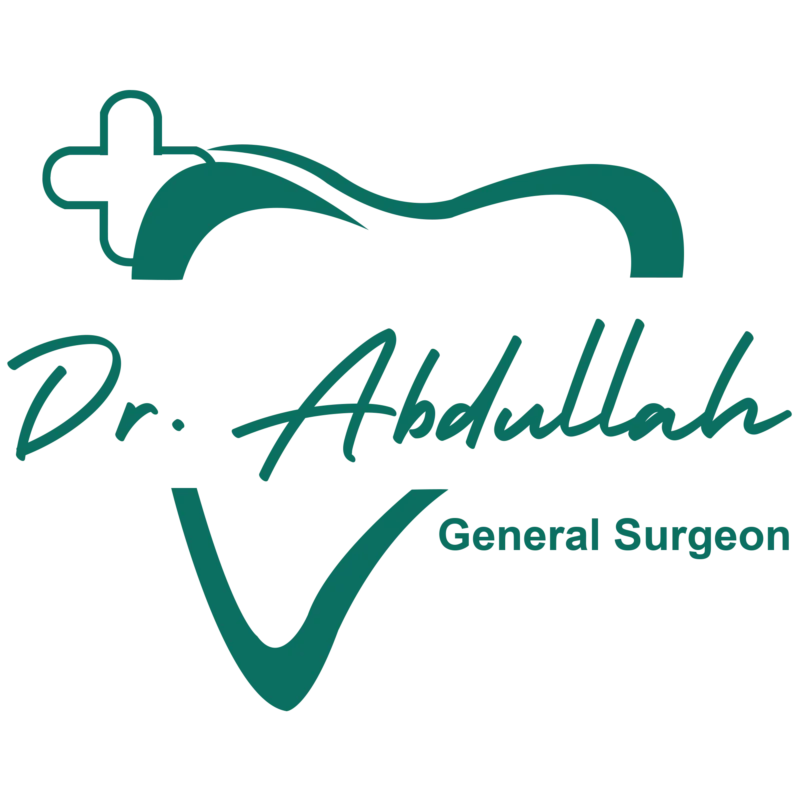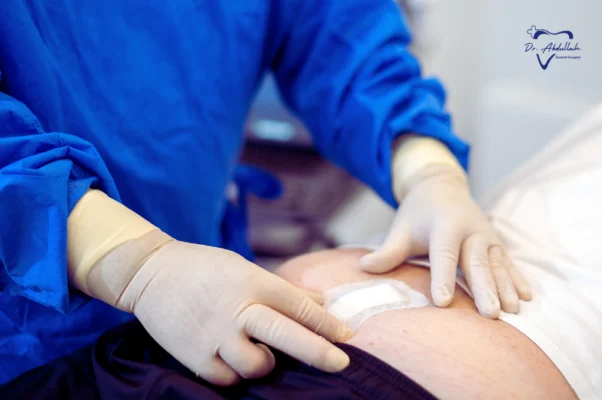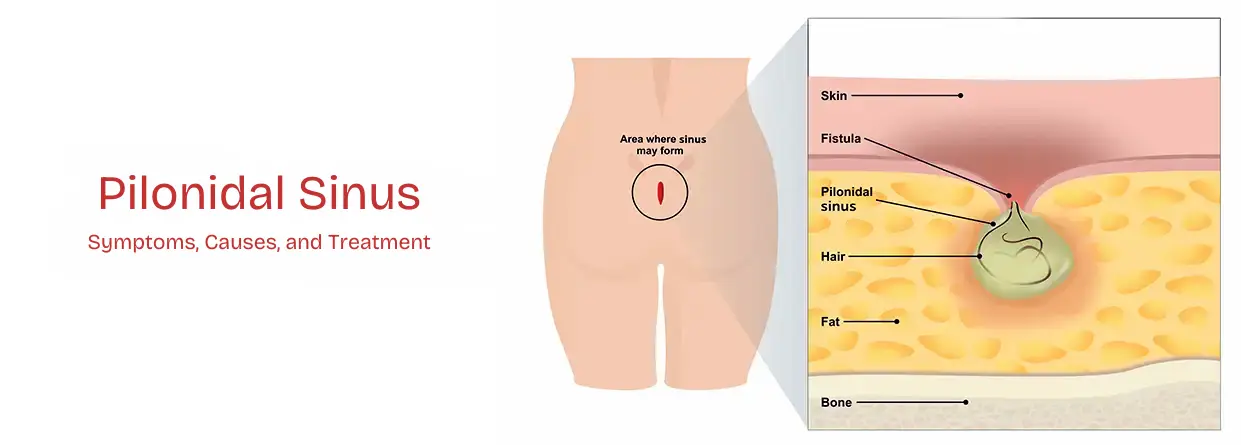Pilonidal sinus is a painful medical condition that involves the intergluteal cleft or an area between your buttocks. In this article, we will discuss what is pilonidal sinus, what are its causes, symptoms and treatment options available. Get the most advanced Pilonidal Sinus Laser Treatment in Karachi with our unique and minimally invasive procedures available only at our clinic.
What is Pilonidal Sinus?
A pilonidal sinus is a small hole in the lower back skin (and a potential route to infection). Most commonly, it develops at the buttocks near the tailbone. When this occurs, it can result in an infected cyst. It can be painful and can have pus or blood. If you have a pilonidal sinus, you may experience pain or discomfort when sitting or moving.
Pilonidal Sinus Disease Causes
Here are several reasons a person may develop a pilonidal sinus:
- Hair Growth: If you are a hairy person, hairs may break and get stuck here
- Friction: Prolonged sitting can lead to friction and hairs may get penetrated in the skin
- Obesity: This is one of the risk factor of having this issue.
- Excessive sweating: This causes your skin to remain wet at most of the time, and your skin becomes more sensitive as a result
By knowing the causes, we can work to prevent them in the future.

Symptoms of Pilonidal Sinus
You must understand the signs and symptoms of pilonidal sinus. Some common symptoms include:
- Pain or discomfort near the tailbone
- Swelling and redness around the area
- Discharge of pus or blood from the hole
When you notice such symptoms, you should see a pilonidal sinus doctor near me and also as soon as possible.
Pilonidal Sinus Treatment Types
Your health care provider may give you some non surgical and surgical options based on the seriousness of your condition.
Non-Surgical Treatments
If this is the first time you are having a pain or discharge your doctor may offer you some simple and easy to do home remedies.
- Pills: If there is an infection antibiotics and anti-inflammatory medications can help.
- Warm Compresses: The application of heat reduces pain and swelling.
- Hygiene: Cleanliness with soft cloth (sterile gauze piece) is essential in this area.
Surgical Treatments
If you have tried all the non surgical options and nothing seems to help your doctor may offer you a surgical option. Some of the most common surgical options are:
1. Incision and Drainage (I&D):
- Purpose: To treat an infected pilonidal abscess.
- Procedure: A small incision is made to drain pus and relieve pain.
- Recovery: This is a temporary solution for infection relief, and is usually performed where there is collected pus inside the cavity. Recovery can take weeks.
2. Excision and Open Healing:
- Purpose: To remove the sinus entirely.
- Procedure: The sinus and surrounding tissue are surgically excised, and the wound is left open to heal naturally.
- Recovery: Healing may take weeks, requiring regular wound care. This approach reduces recurrence rates but at the expense of months of pain and bed rest
3. Excision with Primary Closure (Karydaki’s Procedure)
- Purpose: To remove the sinus and close the wound immediately.
- Procedure: After excision, the wound edges are stitched together.
- Recovery: Healing is faster compared to open healing, but there is a slightly higher risk of recurrence (>20%)
4. Flap Procedures (e.g., Limberg or Bascom Flap):
- Purpose: To remove the sinus and prevent recurrence by flattening the area.
- Procedure: A flap of healthy tissue is used to cover the wound after sinus excision.
- Recovery: Offers lower recurrence rates (<10%) and better cosmetic outcomes but the excision of tissue is bigger with initial few weeks of bed rest. (>4 weeks)
5. Laser Surgery:
- Purpose: A minimally invasive option for chronic cases.
- Procedure: A laser is used to ablate the sinus and infected tissue with minimal damage to surrounding areas.
- Recovery: Faster healing, less pain, and minimal scarring make it a preferred option for many patients. Also the chances of recurrence chances are minimal (<1%)

Which Operation Is Best for the Pilonidal Sinus?
Pilonidal sinus doctor in karachi often recommend laser surgery for pilonidal sinus as a faster healing option due to its minimally invasive nature, resulting in less pain and quicker recovery. However, in more complex cases with significant tissue involvement, or when the case is of recurrent pilonidal sinus traditional surgery may be necessary to ensure thorough removal of affected tissue and better long-term outcomes.
Cost of Pilonidal Sinus Treatment in Karachi
The cost of pilonidal sinus treatment in Karachi varies significantly based on the surgical method and the expertise of the surgeon. Specifically, pilonidal sinus laser surgery in Karachi tends to be more expensive than traditional surgical methods available; however, it is often considered worthwhile due to the benefits of reduced pain and faster recovery times.
Non Surgical Treatment for Pilonidal Sinus in Karachi?
There are limited options available for non-surgical treatment of pilonidal sinus. Though some patients get relief after using medications such as antibiotics but not everyone does.
Finding the Best Pilonidal Sinus Surgeon in Karachi
Dr. Abdullah Iqbal, without any doubt, is the best pilonidal sinus surgeon in Karachi and a trusted pilonidal sinus doctor in Karachi who is very efficient in this field. Currently, he is the only surgeon who is offering pilonidal sinus laser treatment in Karachi. With hundreds of successful cases treated by him and hundreds of 5 star reviews about his services on social media profiles, you should look no further and consult him only for your problem.
Conclusion
Pilonidal sinus is a troublesome condition but effective pilonidal sinus laser treatment in karachi in the form of laser treatment for pilonidal sinus. Knowing your options is key; so when deciding between pilonidal sinus laser treatment vs Traditional Surgery explore all aspects and major differences between them. When considering for laser treatment Dr. Abdullah Iqbal is your only and the best option available in Karachi, Pakistan. If you have any questions or if you need assistance please reach out to us at 03332877351 or 03212363611. With the right knowledge, you can take the best decisions for your health, which is your only wealth.



